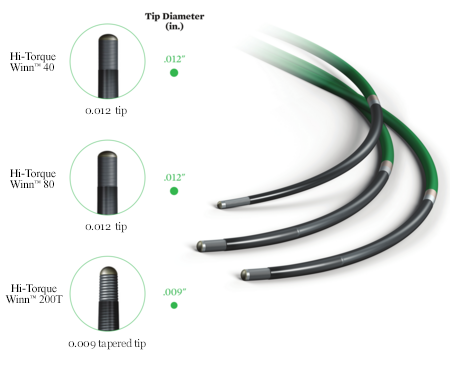The Winn™ family of specialty guide wires enables crossing of challenging lesions with 3 options for guide wire tip stiffness:
- Hi-Torque Winn™ 40
- Hi-Torque Winn™ 80
- Hi-Torque Winn™ 200T

Feel-Cross-Winn
Feel
The excellent tactile feedback and deliverability1 are due to the combination of:
- Intermediate polymer sleeve
- Exposed shapeable tip coils (distal 5 mm)
Cross
- Core-to-tip wire design, with transitionless durasteel core taper, enables pushability as well as outstanding torque over the length of the wire1
- Hydrophilic coating provides excellent lubricity and ease of wire advancement1
Winn
- Three distinct guide wires offer a selection of tip loads and penetration power
- There are varying tip load options of 5.1 g, 11.3 g, and 14.3 g
- The guide wires come in lengths of 190 cm and 300 cm
Ordering Information
| Product | Part Number | Diameter | Length | Tip Load | Tip Style | Units Per Package |
|---|---|---|---|---|---|---|
| Hi-Torque Winn™ 40 | 1012466 | 0.014 in | 190 cm | 5.1 g | Core-To-Tip | 5 |
| Hi-Torque Winn™ 40 | 1012467 | 0.014 in | 300 cm | 5.1 g | Core-To-Tip | 5 |
| Hi-Torque Winn™ 80 | 1012468 | 0.014 in | 190 cm | 11.3 g | Core-To-Tip | 5 |
| Hi-Torque Winn™ 80 | 1012469 | 0.014 in | 300 cm | 11.3 g | Core-To-Tip | 5 |
| Hi-Torque Winn™ 200T | 1012474 | 0.014 in | 190 cm | 14.3 g | Core-To-Tip | 5 |
| Hi-Torque Winn™ 200T | 1012475 | 0.014 in | 300 cm | 14.3 g | Core-To-Tip | 5 |
Data on file at Abbott.
Reference
- Tóth, et al. "How to select a guidewire: technical features and key characteristics". Heart. 2015;101:645–652.
MAT-2006309 v2.0
Hi-Torque™ Guide Wires for
PTCA, PTA and Stents

Indications for Use
This Hi-Torque guide wire is intended to facilitate the placement of balloon dilatation catheters during percutaneous transluminal coronary angioplasty (PTCA) and percutaneous transluminal angioplasty (PTA). This guide wire may also be used with compatible stent devices during therapeutic procedures.
Contradindications
Not intended for use in the cerebral vasculature or with atherectomy devices.
Warnings
This device is designed and intended for ONE-TIME USE ONLY. Do not resterilize and / or reuse.
Carefully observe the instructions under “Do Not” and “Do” below. Failure to do so may result in vessel trauma, guide wire damage, guide wire tip separation, or stent damage. If resistance is observed at any time, determine the cause under fluoroscopy and take remedial action as needed. Use the most suitable guide wire for the lesion being treated.
Do Not:
- Push, auger, withdraw, or torque a guide wire that meets resistance.
- Torque a guide wire if the tip becomes entrapped within the vasculature.
- Allow the guide wire tip to remain in a prolapsed condition.
Do:
- Advance or withdraw the guide wire slowly.
- Use the radiopaque marker of the interventional device to confirm position.
- Examine the tip movement under fluoroscopy before manipulating, moving, or torquing the guide wire.
- Observe the wire under fluoroscopy for tip buckling, which is a sign of resistance.
- Maintain continuous flush while removing and reinserting the guide wire to prevent air from entering the catheter system. Perform exchanges slowly to prevent air entry and / or trauma.
- When reintroducing the guide wire, confirm that the interventional device tip is free within the vessel lumen and that the tip is parallel to the vessel wall.
- Use extreme caution when moving a guide wire through a non-endothelialized stent, or through stent struts, into a bifurcated vessel. Use of this technique involves additional patient risks, including the risk that the wire may become caught on the stent strut.
- Consider that if a secondary wire is placed in a bifurcation branch, this wire may need to be retracted prior to stent deployment, because there is additional risk that the secondary wire may become entrapped between the vessel wall and the stent.
For Winn™ family only: The Winn™ family of guide wires have distal ends of varying stiffness. Operate these guide wires carefully so as not to injure the blood vessel, observing the information in these instructions. The higher torque performance, stiffer distal ends, and / or higher advancement force may present a higher risk of perforation or injury than a guide wire with a more pliable distal end. Therefore, use the guide wire with the least stiff distal end that will treat the lesion, and use extreme care to minimize the risk of perforation or other damage to blood vessels.
Precautions
Guide wires are delicate instruments and should be handled carefully. Prior to use and when possible during the procedure, inspect the guide wire carefully for bends, kinks, or other damage. Do not use damaged guide wires. Using a damaged guide wire may result in vessel damage and / or inaccurate torque response.
Confirm the compatibility of the guide wire diameter with the interventional device before actual use.
Free movement of the guide wire within the interventional device is an important feature of a steerable guide wire system, because it gives the user valuable tactile information. Test the system for any resistance prior to use. Adjust or replace the hemostatic valve with an adjustable valve if it is found to inhibit guide wire movement.
Never attach the torque device to the modified portion of the proximal end of the extendible guide wire; otherwise, guide wire damage may occur, preventing the ability to attach the DOC™ Guide Wire Extension.
Hi-Torque Guide Wires with Hydrophilic Coating: Avoid abrasion of the hydrophilic coating. Do not withdraw or manipulate the hydrophilic-coated wire through a metal cannula or sharp-edged object.
Adverse Events
Potential Adverse Events associated with use of this device may include the following but not limited to perforation, dissection, occlusion, myocardial infarction, embolism and infection.
MAT-2306605 v1.0
